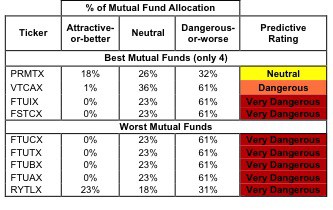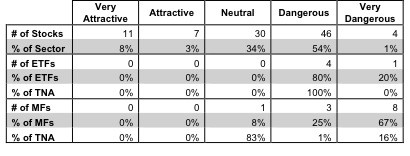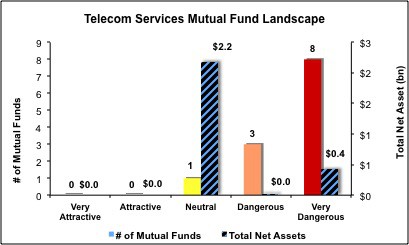The Telecom Services sector ranks ninth out of the ten sectors as detailed in my sector roadmap. It gets my Dangerous rating, which is based on an aggregation of the ratings of 5 ETFs and 12 mutual funds in the Telecom Services sector as of July 13, 2012. Reports on the best & worst ETFs and mutual funds in every sector and style are on my blog.
Figure 1 ranks from best to worst all five Telecom Services ETFs and Figure 2 ranks from best to worst the nine Telecom Services mutual funds that meet our liquidity standards. Not all Telecom Services sector ETFs and mutual funds are created the same. The number of holdings varies widely (from 25 to 53), which creates drastically different investment implications and ratings. The best ETFs and mutual funds allocate more value to Attractive-or-better-rated stocks than the worst ETFs and mutual funds, which allocate too much value to Neutral-or-worse-rated stocks.
To identify the best and avoid the worst ETFs and mutual funds within the Telecom Services sector, investors need a predictive rating based on (1) stocks ratings of the holdings and (2) the all-in expenses of each ETF and mutual fund. Investors need not rely on backward-looking ratings. My fund rating methodology is detailed here.
Investors should not buy any Telecom Services ETFs or mutual funds because none get an Attractive-or-better rating. If you must have exposure to this sector, you should buy a basket of Attractive-or-better rated stocks and avoid paying undeserved fund fees. Active management has a long history of not paying off.
See ratings and reports on all ETFs and mutual funds in this sector on my free mutual fund and ETF screener.
Figure 1: ETFs with the Best & Worst Ratings – Top 5 (only 5 Telecom ETFs available)
* Best ETFs exclude ETFs with TNA’s less than 100 million for inadequate liquidity.
Sources: New Constructs, LLC and company filings
Figure 2: Mutual Funds with the Best & Worst Ratings – Top 5
* Best mutual funds exclude funds with TNA’s less than 100 million for inadequate liquidity.
Sources: New Constructs, LLC and company filings
Rydex Series Funds: Telecommunications Fund (RYMIX) and Rydex Series Funds: Telecommunications Fund (RYMAX) are excluded from Figure 2 because their total net assets (TNA) are below $100 million and do not meet our liquidity standards.
SPDR S&P Telecom ETF (XTL) is my top-rated Telecom Services ETF and T Rowe Price Media & Telecommunications Fund, Inc (PRMTX) is my top-rated Telecom Services mutual fund. XTL earns my Dangerous rating and PRMTX earns my Neutral rating.
ProShares Ultra Telecommunications ProShares (LTL) is my worst-rated Telecom Services ETF and Rydex Series Funds: Telecommunications Fund (RYTLX) is my worst-rated Telecom Services mutual fund. Both earn my Very Dangerous rating.
Figure 3 shows that 18 out of the 98 stocks (only 11% of the total net assets) held by Telecom Services ETFs and mutual funds get an Attractive-or-better rating. However, there are not any Telecoms Services ETFs or mutual funds that get an Attractive-or-better rating.
The takeaway: mutual funds managers pick low-quality stocks and ETFs offer exposure to poor telecom stocks.
Figure 3: Telecom Services Sector Landscape For ETFs, Mutual Funds & Stocks
As detailed in “Cheap Funds Dupe Investors”, the fund industry offers many cheap funds but very few funds with high-quality stocks, or with what I call good portfolio management.
Investors need to tread carefully when considering Telecom Services ETFs and mutual funds, because all of the Telecoms Services ETFs and mutual funds are rated Neutral-or-worse. If investors need exposure to Telecom Services, they should focus on individual stocks. Use my free stock screener to find Attractive Telecom Services stocks.
Neutral Tandem (IQNT) is one of the few Telecom Services stocks that I like right now. It is the only Telecom company that earns an Attractive-or-better rating right now. Neutral Tandem’s ROIC of 13.5% is in the top 10% of all Telecom Services companies. This stock is Attractive becuase it has earned positive economic earnings since 2007 and the stock price reflects negative expectations for future profitability. Today’s price (closed yesterday at $13.69) implies the company’s profits will decline permanently by 3%.
CenturyLink Inc. (CTL) is one of my least favorite stocks held by Telecom Services ETFs and mutual funds and earns my Dangerous rating. CenturyLink does not generate value for its shareholders. It’s ROIC has never exceeded its WACC since 1998 when my model starts. CTL’s ROIC has typically hovered around 6%, but 2011 saw a sharp decline to 3.5%, indicating that the company is sacrificing efficiency and profitability for growth. When a company like CTL, earning ROIC < WACC, continues to grow, the growth only accelerates the destruction of value. Furthermore, standing in line to get paid ahead of shareholders are $23 billion in debt (93% of the company’s equity market cap) and $5 billion in underfunded pension liabilities. The company is going to need to generate much higher returns in order to create value for its shareholders.
42 stocks of the 3000+ I cover are classified as Telecom Services stocks, but due to style drift, Telecom Services ETFs and mutual funds hold 98 stocks.
Figures 4 and 5 show the rating landscape of all Telecom Services ETFs and mutual funds.
Our sector roadmap report ranks all sectors and highlights those that offer the best investments.
Figure 4: Separating the Best ETFs From the Worst ETFs
Figure 5: Separating the Best Mutual Funds From the Worst Mutual Funds
Review my full list of ratings and rankings along with free reports on all 5 ETFs and 12 mutual funds in the Telecom Services sector.
Disclosure: I receive no compensation to write about any specific stock, sector or theme.





